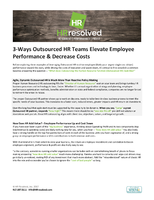Arcom Publishes Policy and Practical Guidance for RoHS Compliance
Kansas City, USA and Cambridge, England - September, 2005 - Today, Arcom has published information about its commitment to the European Union RoHS and WEEE Directives along with some helpful guidelines for its customers and end-users.
The RoHS Directive (Restriction on the use of certain Hazardous Substances) limits the use of 6 substances in the manufacture of certain electronic equipment and comes into effect on July 1st, 2006. The most significant material is lead, a substance used in tin/lead solder and pin plating on electronic components and circuit boards for the last 60 years or so. The WEEE Directive (Waste Electrical and Electronic Equipment) is driven by environmental policy and aims to reduce the volume of waste being dumped into landfill sites by making producers responsible for better design and ultimately the recycling and disposal of equipment. The WEEE Directive became EU law from August 13th, 2005, however many European Member States do not have a practical system in place to administer the Directive.
Arcom recognizes that a significant number of customers use electronic sub-assemblies to control OEM and end-user products such as industrial machinery, medical instrumentation, test and measurement equipment, and telemetry systems - all of which fall outside the scope of the RoHS Directive. There are also certain products such as telecommunications infrastructure equipment which may continue to use lead-based solder - an important aspect for any equipment which performs a critical function in a high reliability communication network. Arcom will continue to support these customers by maintaining production of lead-based products while components are still available. Customers who require RoHS compliant embedded controllers can quickly check the status and availability of key products by reviewing the Product Selection chart. Given the shift by component manufacturers to lead-free production, any new board and system level products introduced from October, 2005 will include RoHS compliant options.
Today, one of the biggest issues facing manufacturers of electrical and electronic equipment is making sense of these Directives, deciding whether your product falls within the scope of the Directives and then deciding what action to take. Arcom has compiled several web pages to serve as practical guidance for equipment producers including a summary of the Directives, a guide to understanding the scope, a list of important third party information sources, as well as examples of 'decision trees' - essential to help you plan your product strategy.
The latest information about RoHS compliant product options can be found on the Arcom web site.
Link to main RoHS / WEEE information page: http://www.arcom.com/RoHS_and_WEEE/default.htm
About Arcom (www.arcom.com)
Arcom, a Spectris company (LSE: SXS.L), is a leading supplier of embedded computer and communications technology to industry. Founded in 1982, Arcom has developed a broad range of standard embedded hardware and software solutions for control, data acquisition and data delivery systems. From its design centers in Kansas City (US) and Cambridge (UK), Arcom is also able to offer Design Services to meet the needs of high volume OEM and specialized customer requirements.
Marketing contact for Arcom:
Jenny McCrae
jmccrae@arcom.com
178 word abstract for magazine editorial and web site news channels only.
Arcom has published information about its commitment to the RoHS and WEEE Directives along with some guidance for its OEM customers and end-users. A significant number of Arcom customers use electronic sub-assemblies to control products which fall outside the scope of the RoHS Directive. There are also certain products such as telecommunications infrastructure equipment which may continue to use lead-based solder. Arcom will continue to support these customers by maintaining production of lead-based products while components are still available. Customers who require RoHS compliant embedded controllers can quickly check the status of key products by the reviewing the Product Selection chart. Today, the most significant issue facing manufacturers of electrical and electronic equipment is making sense of the Directives, deciding whether your product falls within the scope of the Directives and then deciding what action to take. Arcom has compiled several web pages to serve as practical guidance for equipment producers - essential to help you plan your product strategy.
Link to http://www.arcom.com/RoHS_and_WEEE/default.htm




